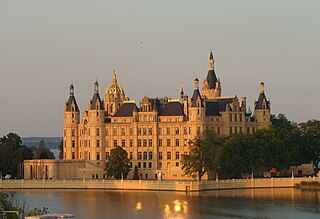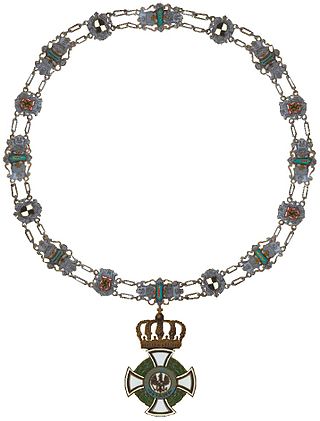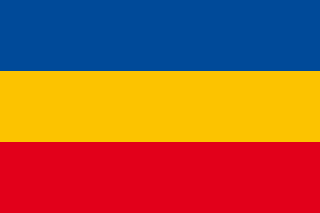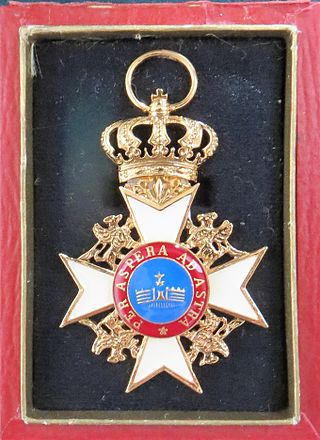
Mecklenburg-Vorpommern, also known by its anglicized name Mecklenburg–Western Pomerania, is a state in the north-east of Germany. Of the country's sixteen states, Mecklenburg-Vorpommern ranks 14th in population; it covers an area of 23,213 km2 (8,963 sq mi), making it the sixth largest German state in area; and it is 16th in population density. Schwerin is the state capital and Rostock is the largest city. Other major cities include Neubrandenburg, Stralsund, Greifswald, Wismar, and Güstrow. It was named after the two regions of Mecklenburg and Vorpommern, and its name means the "nearer part of Pomerania", with the rest now lying in Poland.

Schwerin is the capital and second-largest city of the northeastern German state of Mecklenburg-Vorpommern as well as of the region of Mecklenburg, after Rostock. It has around 96,000 inhabitants, and is thus the least populous of all German state capitals.

Frederick Francis I ruled over the German state of Mecklenburg-Schwerin, first as duke (1785–1815), and then as grand duke (1815–1837).

The House Order of Hohenzollern was a dynastic order of knighthood of the House of Hohenzollern awarded to military commissioned officers and civilians of comparable status. Associated with the various versions of the order were crosses and medals which could be awarded to lower-ranking soldiers and civilians.

The Free State of Mecklenburg-Strelitz was a state of the Weimar Republic established in 1918 following the German Revolution which had overthrown the Grand Duchy of Mecklenburg-Strelitz. The state lasted until the Nazi Party (NSDAP) came to power in Germany and merged the state with the neighbouring Free State of Mecklenburg-Schwerin to form a united state of Mecklenburg on 1 January, 1934.

The Free State of Mecklenburg-Schwerin was a state in the Weimar Republic that was established on 14 November 1918 upon the abdication of the Grand Duke of Mecklenburg-Schwerin following the German Revolution. In 1933, after the onset of Nazi rule, it was united with the smaller neighbouring Free State of Mecklenburg-Strelitz to form the new united state of Mecklenburg on 1 January 1934.

The House and Merit Order of Duke Peter Frederick Louis or proper German Oldenburg House and Merit Order of Duke Peter Frederick Louis was a civil and military order of the Grand Duchy of Oldenburg, a member state of the German Empire. The order was founded by Grand Duke Augustus of Oldenburg on 27 November 1838, to honor his father, Peter Frederick Louis of Oldenburg. It became obsolete in 1918 after the abdication of the last grand duke.

By the Hamburg Agreement on March 8, 1701, Mecklenburg was separated into two duchies with limited autonomy, which formed a collective state–as of 1815, the Grand Duchies of Mecklenburg-Schwerin and Mecklenburg-Strelitz. Since 1755, they had the same constitution and were under the control of the same parliament. In 1815, both parts became Grand Duchies by the Congress of Vienna.

Princess Oskar of Prussia, Countess of Ruppin was a German aristocrat and the wife of Prince Oskar of Prussia.

Freiherr Karl Albert Christoph Heinrich von Kamptz was a German jurist and Prussian Ministers of Justice from 1832 to 1842.

The House Order of Albert the Bear was founded in 1836 as a joint House Order by three dukes of Anhalt from separate branches of the family: Henry, Duke of Anhalt-Köthen, Leopold IV, Duke of Anhalt-Dessau, and Alexander Karl, Duke of Anhalt-Bernburg.
Events in the year 1906 in Germany.

The House of Bassewitz is a German family of ancient nobility whose roots come from the Mecklenburg region. According to tradition, the family was named after the village of Basse. In German hunter-language, Basse refers to a tusker or adult male wild boar. A Tusker Courant is the family's heraldic animal.

The House Order of the Wendish Crown is a dynastic order that was jointly instituted on 12 May 1864 by Grand Duke Friedrich Franz II of Mecklenburg-Schwerin and Grand Duke Friedrich Wilhelm of Mecklenburg-Strelitz. It is the oldest and most senior order of the House of Mecklenburg.

The Order of the Griffon was a State Order of the Grand Duchy of Mecklenburg-Schwerin. Established on 15 September 1884, it was created to honour benevolence and outstanding service to the public. In August 1904, the Order of the Griffon was extended to citizens of the Grand Duchy of Mecklenburg-Strelitz, with the rulers of the two grand duchies serving jointly as the Grand Masters of the order.

The House Order of Henry the Lion In German: Hausorden Heinrichs des Löwen, was the House Order of the Duchy of Brunswick. It was instituted by William VIII, Duke of Brunswick on 25 April 1834. The ribbon of the Order was red with yellow edges. It had five grades: Grand Cross, Grand Commander with Sash, Commander, Knight 1st Class, Knight 2nd Class, plus Medal of Merit for Science and Arts, the Cross of Merit and the Medal of Honour. The Order was named in honour of Henry the Lion, who remains a popular figure to this day.

The House of Bülow is the name of an old German and Danish noble family of Mecklenburg origin, members of which have borne the title of Baron (Freiherr), Count (Graf) or Prince (Fürst).
The 13 Cuirassier regiments of Old Prussia were formed in the mid-17th to mid-18th centuries, and formed the basis of Frederick the Great's vaunted cavalry.
Countess Sabine Elisabeth Oelgard von Bassewitz was a German writer.



























